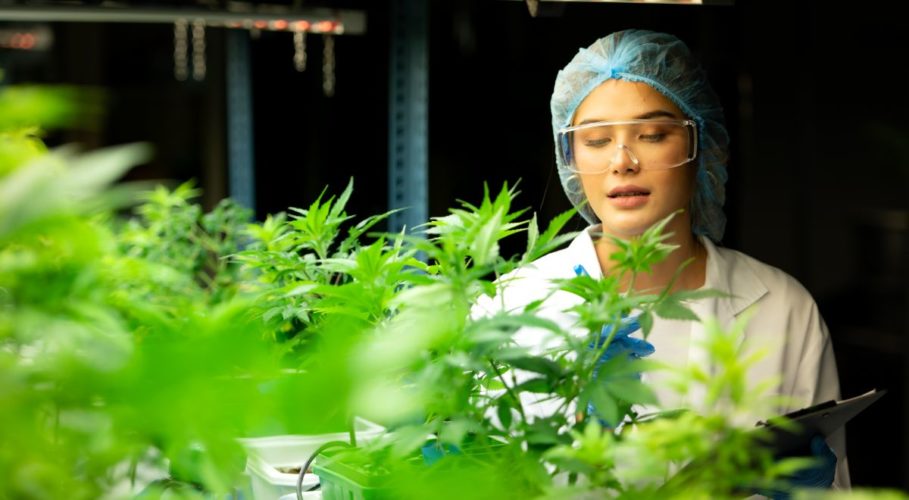Cultivation questions can often stump even the most seasoned cannabis growers.
Indeed, when it’s time to optimize and scale their operations, their biggest challenge is…
Navigating through cultivation questions.
They are clueless about how to do it effectively. This knowledge gap separates hobbyist growers from professional cultivators. But if you don’t know how to address these cultivation issues systematically, reaching that next level of growth will remain a dream.
Cannabis Cultivation and Science Podcast – Episode 111 – Common Cultivation Questions with Brandon Hudson

The guest this week is Brandon Hudson. Brandon is a second generation cannabis cultivator with over 35 years of direct experience with this amazing plant. This week’s show is a bit different, as they get a lot of the same questions at KIS Organics and thought it would be fun to do a show covering a lot of the most common ones.
Table of Contents:
- Soil Reamendment and Testing
- Understanding Bavaria Strains
- Facility Management and Aspergillus Control
- Heavy Metals Concerns in Cultivation
- Marketing Potential with Unique Soils
- Efficient Watering Systems: The Key to Thriving Cannabis Cultivation
- Dealing With Plant Nutrient Issues
- Debunking White Ash Myth
- FAQs in Relation to Cultivation Questions
- Conclusion
Soil Reamendment and Testing

Cultivating cannabis is a complex endeavor, requiring careful consideration of various factors – such as soil reamendment – for optimal growth. One such complexity involves the reamending of soil – an integral part to ensuring healthy plant growth. Brandon Hudson, a renowned figure in this field has some insightful recommendations on how best to go about it.
Importance of Correct Soil Sampling
To begin with, proper soil sampling forms the foundation for effective reamendments. Without precise testing and analysis from reputable labs like those involved in USDA organic agriculture research or long-term cropping systems projects, you’re essentially flying blind when it comes to understanding your soil’s needs.
In essence, getting your hands dirty (pun intended) through correct soil sampling can provide inherently good weed control by identifying deficiencies early enough before they wreak havoc on your crops.
Recommended Materials for Soil Reamendment
Hudson proposes using materials such as pumice or lava rock due to their ability not only to enhance drainage but also to contribute vital minerals that help maintain soil structure over time. Hydroton, which are expanded clay pebbles, come highly recommended too given their moisture conserving properties alongside oxygenating roots effectively.
Apart from these physical amendments, though, incorporating quality compost into soils plays a significant role towards small-scale organic vegetable production since well-rotted compost improves fertility levels drastically while creating beautiful soil structure simultaneously.
Role of Microbial Inoculants in Soil Health
Beyond amending physically, however, introducing microbial inoculants serves to bolster overall health within our soils courtesy of the beneficial microbes they bring onboard. These microorganisms aid nutrient uptake, thereby increasing resistance against diseases whilst promoting root growth among other benefits.
If making homemade solutions isn’t feasible, there exist several commercial products available, including specific microbial inoculant suggested by Hudson himself. Alternatively, brewing up high-quality ingredients into what’s commonly known as ‘compost tea’ could serve similar purposes if applied correctly.
Key Takeaway:
Proper soil sampling is crucial for effective reamendment, allowing growers to identify deficiencies early on. Materials like pumice and compost improve drainage and fertility, while microbial inoculants enhance overall soil health by aiding nutrient uptake and promoting root growth.
Understanding Bavaria Strains
In the realm of cannabis cultivation, diversity is key. Different strains yield different results and one such strain that’s been making waves in the community is Bavaria. But let me tell you this – not all Bavarian strains are created equal.
The bottom line? You need to understand your cannabis strain thoroughly before you start growing it – especially if it’s something as variable as Bavaria.
Variations Amongst Bavaria Strains
Bavarian strains can differ significantly depending upon where they’re sourced from. For instance, a plant purchased from Bioworks may produce different outcomes than one obtained from Sirtis.
- Differences could stem from genetic variation within the plant itself or even slight changes in environmental factors like light intensity and nutrient availability.
- This makes understanding each variant crucial for growers who want optimal growth and harvest potential with these plants.
Influence of Source on Strain Performance
Apart from inherent differences amongst variants, another important factor influencing performance is sourcing.
Sourcing matters, according to Michael Brownbridge at Bioworks whose research indicates that sourcing plays an integral role when considering which variant will best suit your needs as a grower or consumer.
Get ready to dive into the world of Bavaria strains. Not all are created equal, so understanding their variations and sourcing is crucial for optimal growth. Learn more in our guide. #CannabisCultivation #BavarianStrainsClick to Tweet
Facility Management and Aspergillus Control
In the world of cannabis cultivation, cleanliness is next to godliness. This isn’t just about maintaining a neat appearance; it’s also critical for keeping harmful fungi like Aspergillus in check.
The key here? A two-pronged approach: managing your facility layout effectively and ensuring thorough cleaning protocols are followed.
Effective Strategies Against Aspergillus
Moving strategically within your facility can help keep this tricky adversary at bay. Always move from the head house downstream this way you minimize spreading spores or other contaminants back into clean areas.
- Balancing humidity levels since these fungi require both moist and dry conditions during different stages of their life cycle,
- Focusing on proper ventilation as part of moisture conserving organic matter management,
Importance of Cleanliness in Facility Management
Keep your cannabis cultivation facility clean to control Aspergillus. Strategic movement and proper ventilation are key strategies against this harmful fungi. #FacilityManagement #CannabisGrowersClick to Tweet
Heavy Metals Concerns in Cultivation
Cultivating cannabis presents its own unique set of difficulties, including the potential for heavy metal contamination that could harm plants and people. One such challenge is the risk of heavy metal contamination that could not only affect your plants but also pose potential health risks for consumers.
Precautions against Heavy Metal Contamination
To ensure you’re providing inherently good weed control and maintaining a beautiful soil structure created by careful cultivation practices, it’s essential to test your soil before introducing new elements or amendments. This helps identify possible contaminants including harmful substances like lead, cadmium, arsenic or mercury.
You see these heavy metals are sneaky; they can hitch a ride on materials with unknown compositions and make their way into our soils without us even knowing about it. But once there they don’t just sit idle – no sir. They get absorbed by plant roots affecting growth and productivity while accumulating in plant tissues over time leading to failed regulation checks during harvest time under FDA’s proposed produce safety rule.
Benefits of Exclusion Strategy
The best defense as we all know is a strong offense which brings us to an exclusion strategy – this proactive approach involves identifying all possible sources of contamination upfront so you can take steps to prevent them from entering the growing environment right at the outset.
This method saves both time and resources because let’s face it – prevention is always better than cure isn’t it? It allows growers engaged in small-scale organic vegetable production or those managing long-term cropping systems project alike maintain high standards required by regulatory bodies such as USDA Organic Agriculture Research ensuring safe products for end users who rely on us for their medicinal needs.
In essence understanding how heavy metals enter our soils implementing preventive measures becomes crucial part every cultivator should undertake seriously. By doing so we not only assure healthy plants but also contribute towards safer consumer products thus debunking myths around quality being solely dependent factors white ash production alone.
Key Takeaway:
Testing soil for heavy metal contamination before introducing new elements or amendments is crucial in cannabis cultivation. Implementing a proactive exclusion strategy helps prevent contamination, ensuring safe and high-quality products for consumers.
Marketing Potential with Unique Soils
The cannabis cultivation scene is a complex one, laden with numerous considerations that play pivotal roles in the final yield. One such factor, often underappreciated yet crucial to success, lies beneath our feet – soil.
Intriguingly enough, as you continually reuse and amend your soils based on their usage over time they evolve into something truly unique. This uniqueness opens up an avenue for marketing opportunities within your market area.
Value Addition Through Unique Soils
Cannabis growers understand better than anyone else – every detail matters when it comes to cultivating top-quality produce. Experimenting with different amendments and observing how these changes affect plant growth over time can lead to creating a customized soil blend.
This personalized mix not only enhances crop yields but also impacts its flavor profile and overall quality. The use of soil amendments, like organic matter or mineral supplements, alters properties such as pH level or nutrient content leading to improved plant health and productivity.
Marketing Opportunities With Customized Soils
Beyond agricultural benefits; customizing soils presents compelling narratives for marketing purposes too. By emphasizing this distinctiveness in promotional materials, cultivators can set themselves apart from competitors who rely solely on generic commercial potting mixes.
- Telling Your Soil Story:
If we look at Hudson’s debunked myth about white ash being related directly proportional relationship between white ash production and quality, similar misconceptions may exist around soil types used during cultivation. Emphasizing transparency about growing practices creates an emotional connection between consumer preference & brand identity which could drive sales higher. - Potential Standalone Product: Your uniquely amended soils have potential value beyond just being a tool for producing high-quality cannabis crops. For instance, home gardeners interested in trying out their green thumb might be attracted by ready-to-use bags of custom-blended soil proven successful at professional farms.
Key Takeaway:
Customized soils in cannabis cultivation offer not only agricultural benefits but also marketing opportunities. By emphasizing the uniqueness of soil blends and being transparent about growing practices, cultivators can differentiate themselves from competitors and potentially increase sales. Additionally, customized soils have the potential to be sold as standalone products for home gardeners looking for high-quality soil options.
Efficient Watering Systems: The Key to Thriving Cannabis Cultivation
Navigating the cannabis growing realm can be daunting, yet when you have the proper information and resources, it can be much simpler. One such tool that’s often overlooked is an efficient watering system.
Let’s dive into how automated watering systems like the Blue Mat System, are revolutionizing small-scale organic vegetable production in the cannabis industry.
A New Era for Irrigation: Automated Watering Systems
Gone are days where growers had to manually water their plants every day. Now, we have access to advanced technology that does all this work for us – welcome to the era of automated watering systems.
An effective automatic irrigation setup not only provides your crops with consistent moisture conserving organic matter in soil but also frees up valuable time allowing you focus on other aspects of your operation. This ensures optimal plant health by preventing common issues like root rot or nutrient lockout due overwatering underwatering, leading higher yields quality produce.
Picking Your Partner: Choosing Right System For Needs
Navigating through different options available market might seem daunting at first however key lies understanding specific needs based size growing area number plants being cultivated strain type requirements etcetera.
The Blue Mat System, favored by many growers worldwide because its simplicity effectiveness offers great starting point those new automation game. It uses state-of-the-art sensors detect soil moisture levels deliver necessary amount water exactly needed ensuring each plant gets what requires when demands it.
Sustainability In Action: Making Most Of Resources With Automation
Beyond just efficiency convenience these modern solutions offer another crucial benefit – sustainability. By precisely controlling volume frequency irrigations they minimize waste contributing towards environmental conservation efforts too making them perfect choice anyone looking grow certified organic produce sustainably effectively without compromising crop yield quality.
Note: Regardless which system choose remember importance proper installation maintenance practices as improper use could still result wasted resources unhealthy plants despite best intentions.
Key Takeaway:
Automated watering systems, like the Blue Mat System, are revolutionizing cannabis cultivation by providing consistent moisture to plants and freeing up valuable time for growers. These systems improve plant health and yield quality while promoting sustainability through efficient water usage. Proper installation and maintenance are essential for optimal results.
Dealing With Plant Nutrient Issues
Nutrients are the lifeblood of your cannabis plants, and understanding their individual ranges is key to successful cultivation. Each nutrient plays a unique role in plant development, so let’s dive into this topic.
The world of organic cropping systems has shown us that nitrogen aids leaf and stem growth while phosphorus supports root development and flowering. Potassium helps regulate water intake, enzyme activity, and photosynthesis for overall plant health.
Magnesium also plays an essential part; it’s at the heart of chlorophyll production which drives photosynthesis – the process allowing plants to convert light into energy. So if any element falls short in your soil or feeding regimen, you’re looking at less than ideal growing conditions.
Understanding Individual Nutrient Ranges
You’ve got small-scale organic vegetable production going on with these little green guys (or gals), but what happens when they start showing signs of distress? It could be due to lackluster nutrients causing havoc on their tiny bodies.
A dichotomous key can help identify specific deficiencies from contrasting descriptions like leaves yellowing from tip inward versus leaves yellowing from edge inward. You then follow through until you reach a diagnosis – such as nitrogen deficiency or magnesium deficiency – depending on what matches best with observed symptoms. This way, we hand Daniel’s wide-ranging questions about his crops’ nutritional needs back over him armed knowledge.
Tackling Limitations Head-On
If there was ever a time where row cropping makes sense, it would be now. By knowing where limitations begin within our beloved cannabis strains we’re able provide inherently good weed control before things get outta whack. Early detection allows growers adjust feed regimens accordingly thereby promoting healthier more productive crops throughout all stages long-term cropping systems project. Maximum Yield further explains how early intervention strategies prevent extensive damage caused prolonged periods without necessary nutrients ensuring optimal yield quality every stage cultivation process.
Key Takeaway:
Understanding the specific nutrient ranges and deficiencies in cannabis plants is crucial for successful cultivation. By identifying and addressing these issues early on, growers can promote healthier and more productive crops throughout all stages of the cultivation process.
Debunking White Ash Myth
One such myth is the belief that white ash indicates superior quality cannabis.
The truth? According to Brandon Hudson, this isn’t necessarily so. Let’s delve into why this might be.
No Significant Correlation Between White Ash Production and Quality
Hudson suggests there’s no concrete evidence supporting the notion that white ash equates to higher-quality weed. In fact, comprehensive research projects in USDA organic agriculture research centers have found little correlation between these two factors.
This may come as quite a surprise for those who swear by this indicator when assessing their crop’s value or selecting strains from small-scale organic vegetable production units like GreenBudGuru.com. However, it serves as an important reminder not to rely solely on unproven theories when evaluating your produce be it certified organic or otherwise.
Misconception about Cannabis Selection Based on Ash Color
The misconception likely stems from practices observed among tobacco smokers – they often consider white ash indicative of well-cured leaves. But we’re talking about different plants here with distinct properties and thus unique standards for judging quality.
Rather than focusing too much on combustion coloration during hand Daniel’s wide-ranging questions sessions, growers should prioritize other aspects like plant healthiness during growth stages which provide inherently good weed control and proper curing methods post-harvesting more reliable indicators for premium grade product according to long-term cropping systems project studies conducted at Beech Grove Farm started years ago.
A Shift in Perspective: Prioritizing Other Factors Over Myths
In light of these findings, one thing becomes clear: It is crucially important both cultivators involved in horse drawn market garden production alike debunk myths within their practices but also educate consumers accordingly so informed decisions can be made based off facts rather than fiction. This could lead towards better appreciation for genuine qualities defining good cannabis beyond superficial observations like ‘white-ash’ production a beautiful soil structure created over time through moisture conserving organic matter management strategies combined with fallow field cover crops rotation plans perhaps? Only experience managing fruit trees will tell.
Key Takeaway:
White ash is not a reliable indicator of cannabis quality. Research has shown little correlation between white ash production and the overall quality of weed. Instead, growers should focus on factors like plant healthiness during growth stages and proper curing methods for premium-grade products.
FAQs in Relation to Cultivation Questions
What are some questions about agriculture?
Agriculture queries often revolve around soil health, crop rotation, pest control, irrigation methods, and the impact of climate change on farming practices.
How has the cultivation of plants changed society?
Cultivation of plants revolutionized human societies by transitioning them from nomadic hunter-gatherers to settled farmers. This led to the development of civilizations and technological advancements.
What is important for cultivation?
Critical factors for successful cultivation include quality soil, appropriate climate conditions, adequate water supply, proper plant nutrition management, and effective pest control strategies.
What is cultivation answers?
Cultivation refers to preparing land for growing crops. It involves processes like plowing or tilling the land, sowing seeds, and managing growth until harvest time.
Conclusion
Soil reamendment and testing are crucial for maintaining healthy cannabis plants.
Different Bavaria strains can yield varying results, depending on the source.
A clean facility is key in controlling Aspergillus, a fungus that thrives in hot, humid rooms but needs dry air to sporulate.
Heavy metals pose significant risks to cultivation; managing these from the outset is critical.
Your unique soils could be your ticket to standing out in the market place.
An efficient watering system can significantly boost your growing efficiency.
Nutrient issues require careful diagnosis and handling based on individual ranges.
Finally, consider diving deeper into GreenBudGuru.com’s comprehensive guides addressing all essential cultivation questions. We make it easier for you by providing practical insights about soil management, strain variations, facility cleanliness and more! We aim at transforming hobbyist growers into professional cultivators through our systematic approach towards learning. Join us today!
Originally posted 2023-07-23 11:41:37.


 James Alexander
James Alexander